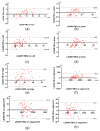Evaluation of Smartphones Equipped with Light Detection and Ranging Technology for Circumferential and Volumetric Measurements in Lower Extremity Lymphedema
- PMID: 40558463
- PMCID: PMC12190992
- DOI: 10.3390/bios15060381
Evaluation of Smartphones Equipped with Light Detection and Ranging Technology for Circumferential and Volumetric Measurements in Lower Extremity Lymphedema
Abstract
Lower extremity lymphedema (LEL) requires precise limb measurements for treatment evaluation and compression garment design. Tape measurement (TM) is the standard method but is time-consuming. Smartphones with light detection and ranging (LiDAR) technology may offer fast and efficient alternatives for three-dimensional imaging and measurement. This study evaluated the accuracy, reliability, and time efficiency of LiDAR measurements compared with those of TM in patients with LEL. A healthy volunteer and 55 patients were included. Circumferences of the foot, ankle, calf, knee, and thigh and the volume were measured using TM and smartphones with LiDAR. The water displacement method was used to validate volume measurements. The measurement time, reliability, correlation, agreement, and systematic differences between the methods were assessed. LiDAR showed excellent reliability in the healthy volunteer (inter-rater intraclass correlation coefficients: 0.960-0.988) and significantly reduced the measurement time compared with TM (64.0 ± 15.1 vs. 115.3 ± 30.6 s). In patients with LEL, strong correlations and agreements were observed for ankle, calf, and knee measurements. However, foot and thigh measurements showed lower correlations and larger discrepancies. LiDAR has excellent accuracy and reliability in measuring the circumference and volume of the lower leg and has the potential to reduce the time required to acquire data. Limitations include lower accuracy for foot and thigh measurements and the current workflow complexity, which requires the use of multiple software tools.
Keywords: LiDAR; circumference measurement; lymphedema; smartphones; volumetric measurement.
Conflict of interest statement
The authors declare no conflicts of interest.
Figures






References
-
- Vilán J., Caamaño J., Cabaleiro M., Arias P., Riveiro B. Automatic 3D modelling of metal frame connections from LiDAR data for structural engineering purposes. ISPRS J. Photogramm. Remote. Sens. 2014;96:47–56. doi: 10.1016/j.isprsjprs.2014.07.006. - DOI
-
- Li Y., Ibanez-Guzman J. Lidar for Autonomous Driving: The Principles, Challenges, and Trends for Automotive Lidar and Perception Systems. IEEE Signal Process. Mag. 2020;37:50–61. doi: 10.1109/MSP.2020.2973615. - DOI
-
- Zhang X., Li J., Xia S., Chen D., Wang R. Geometric Primitives in LiDAR Point Clouds: A Review. IEEE J. Sel. Top. Appl. Earth Obs. Remote. Sens. 2020;13:685–707. doi: 10.1109/jstars.2020.2969119. - DOI
MeSH terms
Grants and funding
LinkOut - more resources
Full Text Sources
Medical

